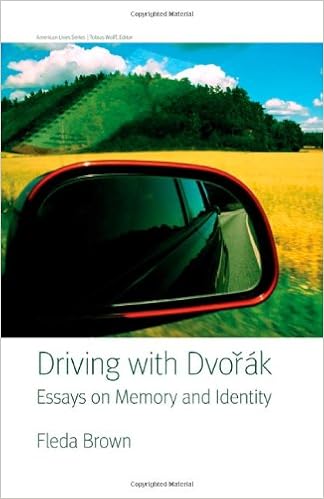Fleda
Brown’s memoir, Driving with Dvorak, selected by Tobias
Wolff, for the American Lives Series from University of Nebraska,
invokes the elegiac tradition while Brown drives us across spaces as
wide as America itself: the architecture of family, marriage, divorce
and re-marriage, and the essential defining of self. And Brown pulls
us into her history, her ruminations on identity, “Who am I? How do
I begin?” And where Brown goes her reflective eye and poetic voice
follow.
She
is at home in her skin, her body, but cuts memories to the bone as if
she were a butcher, separating the lean from the fat. In the title
essay, Brown’s father, “someone to love and fear” appears to
her as a greaser, and then as memories of hot summers where his edge
boiled over into rage. At times you feel she wants to let him off the
hook, as if she understands that he was trying to keep the family
together, her sisters, their needs, and the exhaustive needs of her
brother, Mark, disabled and inert. There is weight and pain in her
memories, wondering what it would be like if her father and brother
were to drown when Mark goes overboard one summer day, “I don’t
know what I want to happen, what I feel, what solution would make the
world a better place for us.” These truths turn up like polished
bones in the long tidal rhythms of her prose. I suppose that’s
what’s cool about the music of elegy, it’s haunting, aching, and
pretty, and touches a key of doom that humans feel when they love too
much.
In
“Hiking with Amy,” her stepdaughter, Brown questions identity,
family, relationships, her chorus, if you will, but in “Hiking”
she also questions her age, her ability to maintain pace with her
stepdaughter. She goes to the gym, but what does that really mean,
anyway? Maintenance? A kind of totem against becoming one’s
parents? And indeed Brown is “pitting myself against
so I won’t have her dowager’s hump, walking and running, watching
my eating so I won’t have her stomach. Everyday I wake figuring how
to live.” And throughout the hike and essay her sense of self is
mercurial, she is ten, she is ancient, she has no gender, no
definitions but the act of hiking and the very fact of the wilderness
about her. Her identity wavers and gives, and enlarges with
experience.
Brown’s
sense of identity and how our whole lives are built around
reconnecting with who we are, and who we want to become is compared
to buying a new car, in the essay “New Car,” where vehicles, like
marriages, become the sum of many dings and defects. Like the many
cars we have had a relationship with, there are memories and
touchstones to each vehicle. In “Car” Brown interrupts her
narrative with mini factual narratives about the makes and models she
has had a relationship with over the years, and the result is an
emotional undercut to Brown’s history and memory. A brief reminder
that the world is a place that is made and sold and bought, and that
we simply maintain.
Throughout
these essays, the poet’s voice is consistent; her eye is
consistent, even though the speaker aches to be redefined. Consider
“Showgirls” an essay about her ill sister, about Vegas, about
poetry, and always about one’s search of self-identity, a search
that Brown understands is a loop, and is endless and always. Brown’s
search is our search too, and when she returns to memories of her
father she does so tentatively; the ache in such hesitation ripples
throughout her prose. “Where does one go to find life? There is
only the vertical, only the awareness of each moment, even as it
gathers its own version of past and future to itself.” There is
only the moment, and how we adapt to its additions and subtractions,
a reflection in the rear view mirror that changes like the landscape
we pass through.

Comments